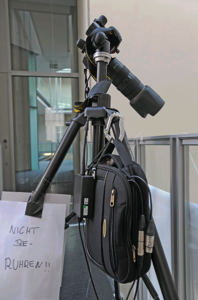
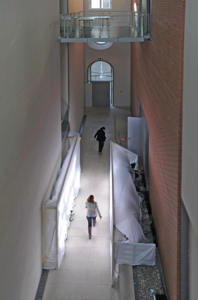
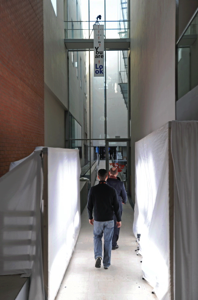
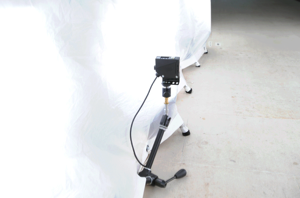
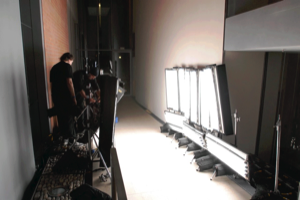
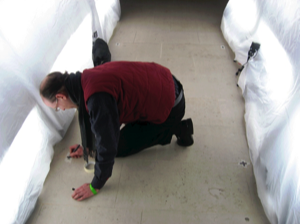

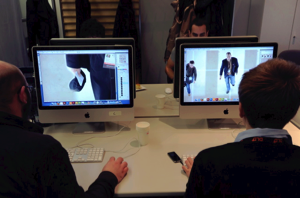

A 12-Gigapixel group photo
To capture images of the participants of DLD 2009 I used an automatic camera mounted on a bridge above a corridor between the two buildings of the conference venue.
I aligned an optical proximity sensor built for industrial automation to trigger about four shots when a person would pass through the camera's field of view. The sensor and the camera were linked by radio.
As thousands of images were meant to be tiled during the conference it was clear from the beginning that there wouldn't be much time to manually tweak each image, so I took great care to light the area very uniformly. We achieved this by rigging 20 Kinoflo soft lights to form some kind of light tunnel in the corridor.
Amazingly, neither the bright lights nor the 3-meter-high banner hanging from the camera bridge ("Look, you are in the picture") helped a lot to make people realize what was going on at first, but by day 2 of the conference images began to show people performing little stunts for the camera.
The camera recorded around 30,000 images during the first two days of the conference out of which 1200 were chosen to meet the technical criteria for tiling. These images probably show most of the participants. Since there was a lot of trafic between the buildings some people got recorded several times. This is not a DLDscape bug but a feature.
Ten Photoshop operators worked in four shifts to place the images on background tiles created from photos of the unlit floor. When the conference closed on day 3 we were able to show only one half of the DLDscape because the saving of the full view was still in progress.
As the final picture had grown to 100,968 by 123,324 pixels, simply writing the file to disc took Photoshop around four hours. It's an interesting experience to watch even the "preparing to save"-bar kind of frozen on the screen.
Printing this picture at a resolution of 300ppi typical for high-quality photo output would yield a print more than 10 meters wide.
To make the picture viewable at full resolution on the web it was converted to a "zoomify" image stack comprising 254,208 mosaic tiles of different detail levels so the browser will refresh only those parts of the picture that are visible at the chosen zoom level. Exporting and uploading that stack to my website took almost two days. So if you feel the urge to pixel-peep the DLDscape for imperfections, please note that it's not likely I will fix them any time soon. (Presumably due to an operator error when handing over from one night to a morning shift, about 10 of the 1152 images are identical.)
I wish to thank everyone who contributed to this unique project, in particular:
DLD for providing the infrastructure, and Steffi Czerny personally
DLD team: Clemens Fetzer, Rupert Schäfer, Sabine Schmid, Arthur Schmidt
HypoVereinsbank: Ulrich Kurzawa
first officer on the Photoshop galley: Werner Nienstedt
galley slaves: Benjamin Alsleben, Stefan Dreer, Joachim Fröstl, Martin Heigermoser, Robert Kiemele, Marcel Kovac, Zazralt Magic, David Navratil, Daniel Riedel
machinists: Ralph Mäntele, Andreas Vollmer
and Jochen Wegner
To capture images of the participants of DLD 2009 I used an automatic camera mounted on a bridge above a corridor between the two buildings of the conference venue.
I aligned an optical proximity sensor built for industrial automation to trigger about four shots when a person would pass through the camera's field of view. The sensor and the camera were linked by radio.
As thousands of images were meant to be tiled during the conference it was clear from the beginning that there wouldn't be much time to manually tweak each image, so I took great care to light the area very uniformly. We achieved this by rigging 20 Kinoflo soft lights to form some kind of light tunnel in the corridor.
Amazingly, neither the bright lights nor the 3-meter-high banner hanging from the camera bridge ("Look, you are in the picture") helped a lot to make people realize what was going on at first, but by day 2 of the conference images began to show people performing little stunts for the camera.
The camera recorded around 30,000 images during the first two days of the conference out of which 1200 were chosen to meet the technical criteria for tiling. These images probably show most of the participants. Since there was a lot of trafic between the buildings some people got recorded several times. This is not a DLDscape bug but a feature.
Ten Photoshop operators worked in four shifts to place the images on background tiles created from photos of the unlit floor. When the conference closed on day 3 we were able to show only one half of the DLDscape because the saving of the full view was still in progress.
As the final picture had grown to 100,968 by 123,324 pixels, simply writing the file to disc took Photoshop around four hours. It's an interesting experience to watch even the "preparing to save"-bar kind of frozen on the screen.
Printing this picture at a resolution of 300ppi typical for high-quality photo output would yield a print more than 10 meters wide.
To make the picture viewable at full resolution on the web it was converted to a "zoomify" image stack comprising 254,208 mosaic tiles of different detail levels so the browser will refresh only those parts of the picture that are visible at the chosen zoom level. Exporting and uploading that stack to my website took almost two days. So if you feel the urge to pixel-peep the DLDscape for imperfections, please note that it's not likely I will fix them any time soon. (Presumably due to an operator error when handing over from one night to a morning shift, about 10 of the 1152 images are identical.)
I wish to thank everyone who contributed to this unique project, in particular:
DLD for providing the infrastructure, and Steffi Czerny personally
DLD team: Clemens Fetzer, Rupert Schäfer, Sabine Schmid, Arthur Schmidt
HypoVereinsbank: Ulrich Kurzawa
first officer on the Photoshop galley: Werner Nienstedt
galley slaves: Benjamin Alsleben, Stefan Dreer, Joachim Fröstl, Martin Heigermoser, Robert Kiemele, Marcel Kovac, Zazralt Magic, David Navratil, Daniel Riedel
machinists: Ralph Mäntele, Andreas Vollmer
and Jochen Wegner